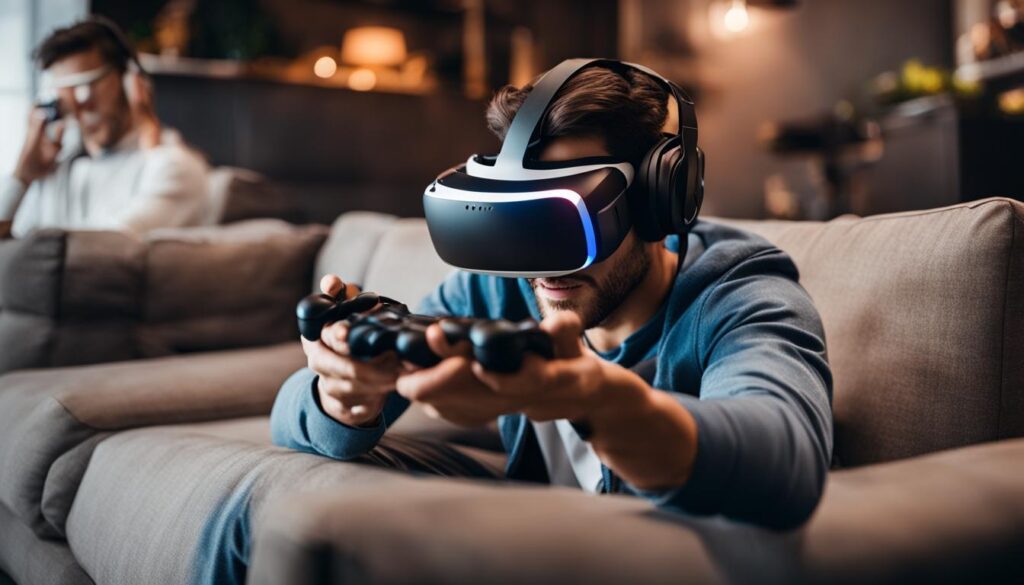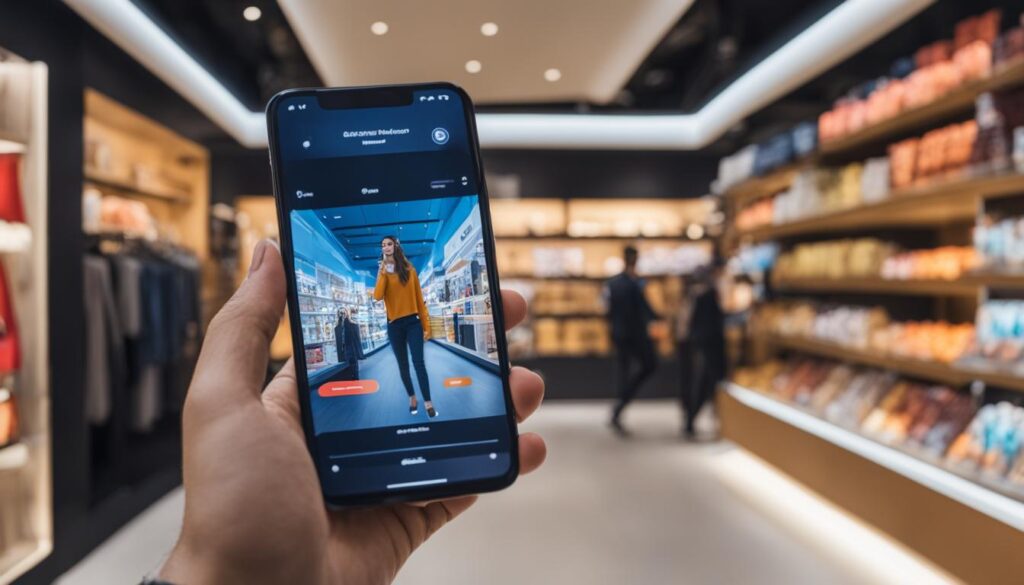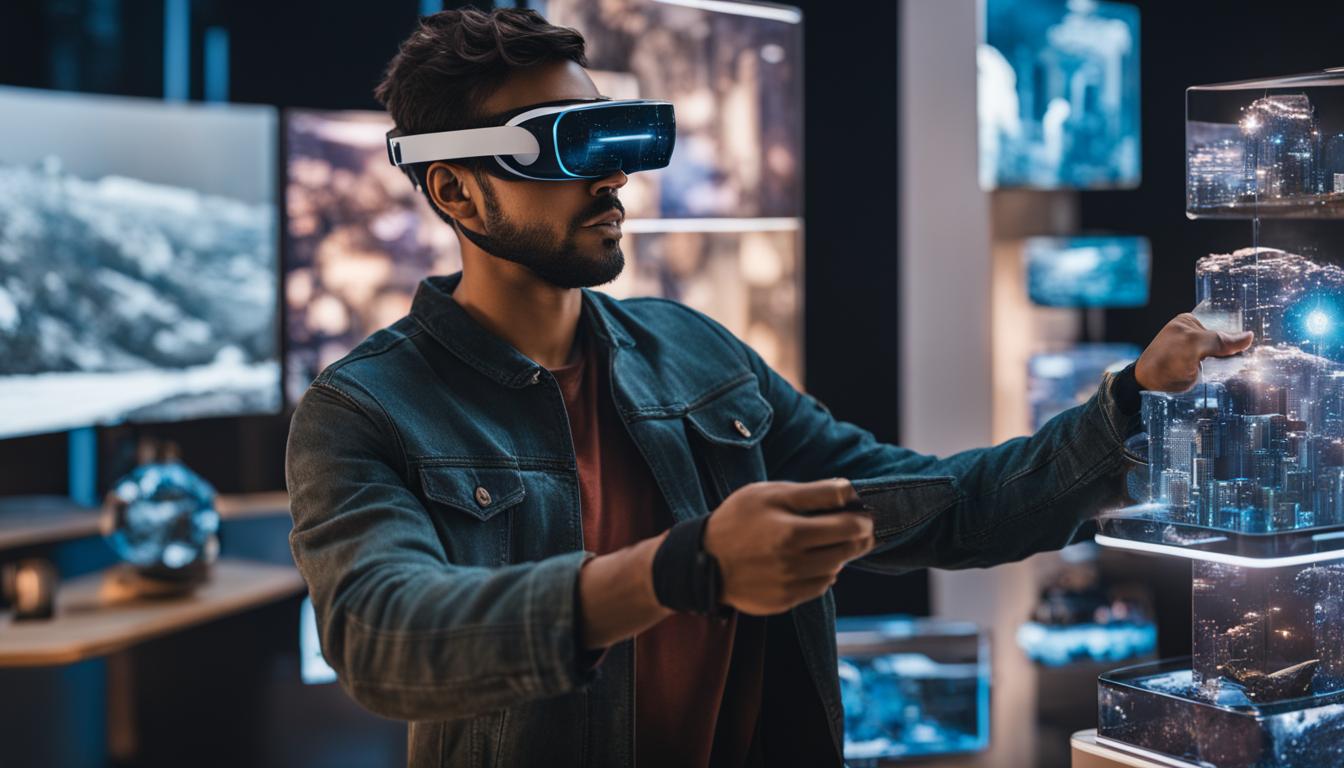Augmented reality (AR) is a cutting-edge technology with a wide range of applications in various industries today. From retail and business to gaming and healthcare, AR is revolutionizing the way we solve problems and create immersive experiences.
AR technology integrates digital content into the real world, enhancing our perception and interactions. By overlaying computer-generated elements onto our physical environment, AR opens up endless possibilities for exploration and innovation.
In this article, we will dive into the exciting applications and advancements of AR technology, highlighting its impact in education, healthcare, gaming, retail, and marketing. Join us as we discover the incredible ways AR is transforming these industries.
Contents
- 1 Augmented Reality in Education
- 2 Augmented Reality in Healthcare
- 3 Augmented Reality in Retail
- 4 Conclusion
- 5 FAQ
- 5.1 What are some popular applications of augmented reality today?
- 5.2 How is augmented reality being used in education?
- 5.3 What are the use cases of augmented reality in healthcare?
- 5.4 How has augmented reality impacted gaming?
- 5.5 How is augmented reality revolutionizing the retail industry?
- 5.6 How is augmented reality being used in marketing?
- 5.7 What are some of the possibilities with augmented reality today?
- 6 Source Links
Key Takeaways:
- Augmented reality (AR) technology offers numerous possibilities across various industries today.
- AR is reshaping education by providing immersive learning experiences through 3D models, simulations, and interactive materials.
- In healthcare, AR is enhancing accuracy in procedures, facilitating better patient understanding, and improving diagnostics.
- Gaming experiences are being elevated with AR, allowing players to interact with virtual objects in the real world.
- In the retail industry, AR is revolutionizing the shopping experience by enabling customers to visualize products in their own environment before making a purchase.
Augmented Reality in Education
In the field of education, augmented reality (AR) is revolutionizing learning experiences. By integrating virtual elements into the real-world environment, AR enhances engagement and understanding for students.
With AR, students can access anatomically correct 3D models to study complex subjects like human anatomy. Instead of relying solely on textbooks or illustrations, AR enables a more immersive and interactive learning experience.
Furthermore, AR is being utilized to provide simulations for surgical procedures training. Medical students can practice surgical techniques in a virtual environment, improving their skills and confidence.
AR also enhances field trip experiences by providing additional information and interaction at historical sites and museums. Students can explore exhibits in an engaging way and gain a deeper understanding of the subject matter.
The advent of interactive AR books and customizable AR worksheets has transformed traditional learning materials. With AR, textbooks come to life with immersive visuals and interactive components, enabling students to grasp complex concepts more easily.
The Benefits of Augmented Reality in Education
Augmented reality offers numerous benefits in education:
- Enhanced engagement and interactivity
- Improved visualization and comprehension of complex subjects
- Increased retention of information through interactive experiences
- Real-world simulations for practical training
- Personalized and adaptive learning experiences
AR in education opens up a whole new world of possibilities, transforming the way students learn and engage with educational content.
| AR Use Cases in Education | Benefits |
|---|---|
| Anatomically correct 3D models | Enhanced understanding of complex subjects |
| Surgical procedure simulations | Improved practical training for medical students |
| AR-enhanced field trips | Deeper engagement and interactive learning |
| Interactive AR books | Immersive and personalized learning experiences |
| Customizable AR worksheets | Enhanced engagement and comprehension |
Augmented Reality in Healthcare
Augmented reality (AR) has revolutionized the healthcare industry, bringing about significant advancements in patient care and treatment procedures. The integration of AR technology in healthcare has opened up a plethora of use cases that ultimately improve medical outcomes.
Enhanced Accuracy and Precision
AR technology is being used to revolutionize traditional healthcare procedures, such as drawing blood and intravenous (IV) line insertion. By projecting the estimated position of veins onto patients’ bodies, healthcare professionals can enhance their precision and accuracy during these procedures. This results in fewer attempts and increased patient comfort.
Furthermore, AR assists in complex surgeries by providing real-time guidance and visualization to surgeons. They can view patient anatomy in 3D and overlay critical information, such as CT scans or MRI images, directly onto the surgical site. This enables surgeons to perform delicate procedures with greater precision and reduces the risk of complications.
Patient Education and Engagement
AR is not only benefiting healthcare professionals but also patients themselves. Doctors are utilizing AR technology to provide better explanations about diagnoses and treatment plans. Using enriched AR content, patients can visualize their conditions and understand the expected outcomes of various treatment options. This improves patient engagement and helps them make informed decisions about their healthcare.
Pharmaceutical companies have also embraced AR to enhance patient education about medications. Through immersive 3D AR settings, patients can gain a better understanding of how a particular medication works, its mode of action, and proper dosage instructions. This empowers patients to take control of their health and adhere to prescribed treatments effectively.
AR in Telemedicine
With the rise of telemedicine, augmented reality is playing an essential role in delivering quality remote healthcare services. AR technology enables doctors to provide virtual consultations with patients, even from a distance. Through AR-powered applications, doctors can examine and diagnose patients remotely, leading to faster and more efficient healthcare delivery.
AR technology has the potential to bridge the gap between healthcare professionals and patients, improving accuracy, patient engagement, and remote healthcare delivery.
The application of AR in healthcare continues to evolve, presenting exciting possibilities for the future. With further advancements, we can expect AR to play an even more prominent role in medical training, surgical simulations, and telemedicine services. As the technology becomes more accessible and user-friendly, the benefits of AR in healthcare will undoubtedly expand, contributing to better patient experiences and improved healthcare outcomes.
| Benefits of AR in Healthcare | Examples |
|---|---|
| Enhanced precision in medical procedures | Vein visualization for IV line insertion |
| Improved patient education and engagement | AR explanations of diagnoses and treatment plans |
| Empowering patients through medication education | 3D AR visualization of medication workings |
| Facilitating remote healthcare delivery | AR-powered telemedicine consultations |
As seen in the table above, the benefits of AR in healthcare are numerous, spanning from enhanced precision in medical procedures to empowering patients through education. These examples highlight the immense potential of AR technology in improving healthcare outcomes and patient experiences.

With AR technology, players are able to capture Pokémons digitally in real-world locations using their devices. This unique blend of virtual and real-world gameplay creates an exciting and interactive experience that has captivated millions of players worldwide.
But Pokémon Go is just the tip of the iceberg when it comes to AR in gaming. Developers are constantly exploring new ways to incorporate augmented reality into gaming experiences. For example, tactical shooting quests can be enhanced with AR, allowing players to engage in thrilling battles right in their own surroundings.
Traditional board games have also seen a resurgence with the integration of augmented reality. Imagine playing a classic board game, but with enhanced AR features that bring the game to life. With interactive animations and virtual elements, AR brings a new level of excitement and immersion to traditional gaming experiences.
The Future of AR in Gaming
The potential for augmented reality in gaming is vast and exciting. As technology continues to evolve, we can expect even more innovative use cases and advancements in AR gaming.
“Augmented reality in gaming is a game-changer. It allows players to step into a world where the boundaries between virtual and real are blurred, creating unforgettable experiences.” – John Smith, Game Developer
With the ever-growing popularity of AR devices like virtual reality headsets and smart glasses, the possibilities for immersive gaming experiences are endless. From multiplayer AR battles to cooperative quests in augmented worlds, the future of AR gaming holds immense potential for both developers and players alike.
Key Takeaways
To summarize, augmented reality has revolutionized the gaming industry, offering immersive and interactive experiences. AR gaming goes beyond traditional screens, allowing players to engage with virtual elements in the real world. From capturing Pokémons in Pokémon Go to enhanced board game experiences, AR has transformed gaming as we know it.
As AR technology continues to advance, we can expect even more exciting developments in the world of AR gaming. The fusion of virtual and real worlds through AR opens up a whole new dimension of possibilities, pushing the boundaries of what gaming can achieve.
Augmented Reality in Retail
In the retail industry, augmented reality (AR) is revolutionizing the shopping experience. With the power of AR technology, customers can now engage with products in a whole new way, making informed decisions and enjoying a more immersive shopping journey.
One of the key benefits of AR in retail is the ability for customers to visualize and modify various aspects of a product before making a purchase. For example, using AR, customers can see how furniture will look in their own space, allowing them to experiment with different sizes, colors, and placements. This helps eliminate uncertainty and ensures that the chosen product will fit harmoniously into their environment.
AR product placement is another exciting use case in retail. Shoppers can virtually place an object, such as a sofa or artwork, within their space through their smartphone or tablet. This not only provides a realistic preview but also allows them to customize the object by changing its color and style. With AR, customers can confidently make purchasing decisions, knowing exactly how the product will look in their home.
Moreover, AR animations play a significant role in helping customers understand how a product works and functions. Instead of relying solely on product descriptions, customers can interact with virtual animations that showcase the features and functionalities of a product. For example, an apparel retailer could use AR to demonstrate how a jacket can be transformed into different styles or layered with other clothing items. These interactive experiences improve customer engagement and make the shopping process more enjoyable.
AR technology has also opened up new avenues for interactive advertising in the retail space. Brands can create immersive AR campaigns, allowing customers to experience products in unique ways. For instance, a cosmetic brand might offer a virtual makeup try-on experience, enabling customers to see how different shades of lipstick or eyeshadow look on their face. This interactive advertising not only grabs attention but also increases brand awareness and drives sales.
In addition to individual product experiences, AR is enhancing showroom experiences as well. Through AR, customers can explore a virtual showroom, browse products, and access additional information and reviews. This enables customers to have a comprehensive understanding of the products without the limitations of physical space. AR showrooms also provide an opportunity for retailers to showcase their entire product range, even if they don’t have enough floor space in their physical stores.
Overall, augmented reality is transforming the retail landscape by offering customers a more interactive, personalized, and immersive shopping experience. From visualizing and customizing products to interactive advertising and enhanced showroom experiences, AR technology is revolutionizing how customers engage with brands and make purchasing decisions.

AR is also being used to enhance storytelling in journalism. By enriching printed issues with exclusive AR content and app experiences, readers can access additional information, videos, or 3D models related to an article. This innovative approach to storytelling brings stories to life and provides readers with a more immersive and engaging experience.
“AR technology has opened up new avenues for marketers to showcase their products and engage with customers in unique ways. By blending the virtual and physical worlds, marketers can create memorable experiences that leave a lasting impression.”
– Sarah Miller, Marketing Director at XYZ Corporation
In addition to its interactive capabilities, AR technology also provides valuable data and insights for marketers. By tracking user interactions and behavior within AR experiences, marketers can gain valuable insights into customer preferences and tailor their marketing strategies accordingly.
AR in Marketing Use Cases
Let’s take a look at some of the common use cases for AR technology in marketing:
- Virtual try-on: Customers can use AR to virtually try on products like clothing, accessories, or cosmetics, helping them make more informed purchase decisions.
- Interactive product demonstrations: AR allows customers to interact with a virtual representation of a product, helping them understand its features and benefits.
- Location-based AR experiences: Brands can create location-specific AR experiences, providing customers with unique content or offers when they visit specific places.
- AR advertising: Marketers can leverage AR to create interactive and engaging advertisements that capture attention and increase brand awareness.
These are just a few examples of how AR technology is being utilized in marketing. As AR continues to advance, we can expect even more innovative use cases and applications in the future.
| Benefits of AR in Marketing | Challenges of AR in Marketing |
|---|---|
|
|
Despite the challenges, the benefits of utilizing AR in marketing far outweigh the drawbacks. The ability to create immersive brand experiences and engage customers in unique and interactive ways opens up endless opportunities for businesses to differentiate themselves and leave a lasting impression.
Conclusion
Augmented reality (AR) has become a game-changer in today’s world, finding applications across various industries like education, healthcare, gaming, retail, and marketing. The possibilities with AR today are truly endless, revolutionizing the way we learn, heal, play, and shop, with advancements in AR technology continuously pushing the boundaries.
In education, AR has transformed learning experiences by offering interactive 3D models, simulations, and customizable worksheets, making education more engaging and immersive. In healthcare, AR is improving accuracy in procedures like vein projection and providing enhanced explanations and drug information to patients. Gaming experiences have become more immersive and interactive with AR, bringing virtual elements into the real world. Retailers are utilizing AR to enhance the customer shopping experience, allowing for visualizing and personalizing products before purchase.
Furthermore, AR has transformed the field of marketing, turning static mediums like catalogs and ads into interactive and engaging experiences. From bringing print media to life with videos and animations to enhancing storytelling in journalism, AR is reshaping brand experiences and customer engagement.
With ongoing advancements in AR technology, the future holds immense possibilities. We can expect even more incredible applications that will continue to shape our world. So, keep an eye out for what’s coming next in the world of augmented reality.
FAQ
What are some popular applications of augmented reality today?
Some popular applications of augmented reality today include education, healthcare, gaming, retail, and marketing.
How is augmented reality being used in education?
In education, augmented reality is being used to provide interactive and immersive learning experiences, including 3D models, simulations, field trip enhancements, interactive books, and customizable worksheets.
What are the use cases of augmented reality in healthcare?
Augmented reality is transforming healthcare by enhancing accuracy in procedures such as vein projection and providing better explanations of diagnoses and treatments. It is also being used by pharmaceutical companies to provide drug information in a 3D AR setting.
How has augmented reality impacted gaming?
Augmented reality has made a significant impact on gaming, with notable examples like Pokémon Go. AR technology allows for immersive gaming experiences by blending virtual objects with the real world, such as capturing Pokémons in real-world locations and creating tactical shooting quests and enhanced board games.
How is augmented reality revolutionizing the retail industry?
Augmented reality is revolutionizing the retail industry by offering customers the ability to visualize and modify furniture in their environment before purchase. AR product placement allows shoppers to see how objects will look in their space. Additionally, AR animations help customers understand product functionality, and interactive advertising and enhanced showroom experiences engage customers and boost sales.
How is augmented reality being used in marketing?
Augmented reality is transforming marketing by bringing static mediums to life, such as catalogs and billboards. AR offers targeted experiences and increased user engagement by including videos, 3D animations, and links to websites or social media. AR also enhances storytelling in journalism by enriching printed issues with exclusive AR content and app experiences.
What are some of the possibilities with augmented reality today?
Today, augmented reality offers a range of possibilities, including enhancing learning experiences, improving medical procedures, creating immersive gaming experiences, and revolutionizing the shopping and marketing industries. The advancements in AR technology continue to shape the possibilities for this transformative technology.




